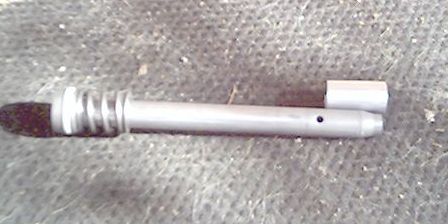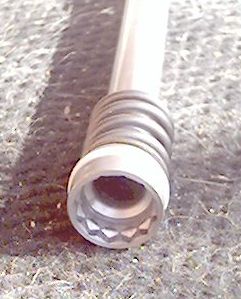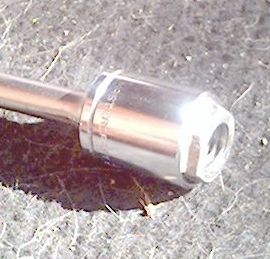 This is a post-'93 stock damper rod, with two compression damping holes near the bottom, each
about 3/16"" in diameter. It fits into the tapered lower sleeve at the bottom of the fork, which is there to
cushion complete compression.
This is a post-'93 stock damper rod, with two compression damping holes near the bottom, each
about 3/16"" in diameter. It fits into the tapered lower sleeve at the bottom of the fork, which is there to
cushion complete compression.
Some measurements of the stock springs:
Spring Outer Diameter 30 mm 1.1811 inches
Wire Diameter 5 mm 0.1969"
23 high-pitch coils, 35 low-pitch
Found a Simple Spring Constant Calculator on the web, and the calculated spring rate for the stock 543mm springs was 0.724 kg/mm.
Advice on spring shortening came from Tech: Stiffer Springs For Free! Coil Spring Tuning Secrets by: Rick Sieman and How to make the Yamaha XS11 Handle.
At the high-pitch end, I cut off about 1 1/4 turns by heavily nicking the spring wire with a file, then breaking off with a vice. I then propane-torch heated to bend flat and filed to make flatter. Net result is 529mm long and a bit stiffer than stock (0.737 kg/mm), but providing the same amount of preload. These calculated figures are initial spring rates for these progressive springs, the final spring rate (when all the close-pitch coils are collapsed) is calculated as around 1.7 kg/mm.
 This is a post-'93 stock damper rod, with two compression damping holes near the bottom, each
about 3/16"" in diameter. It fits into the tapered lower sleeve at the bottom of the fork, which is there to
cushion complete compression.
This is a post-'93 stock damper rod, with two compression damping holes near the bottom, each
about 3/16"" in diameter. It fits into the tapered lower sleeve at the bottom of the fork, which is there to
cushion complete compression.
 FYI, the top of the damper is broached to fit a 5/8" dia. nut which is 24mm|15/16" across the flats.
FYI, the top of the damper is broached to fit a 5/8" dia. nut which is 24mm|15/16" across the flats.
 So
I stuck said nut (with a light coating of masking tape) half way into a 24mm socket, and used it and a
bunch of extensions to hold the damper rod while loosening and tightening the bottom bolt.
So
I stuck said nut (with a light coating of masking tape) half way into a 24mm socket, and used it and a
bunch of extensions to hold the damper rod while loosening and tightening the bottom bolt.
 This is the same damper rod, with the stock holes drilled out to 5/16", and 4 additional 5/16" holes above
the stock holes, as recommended by RaceTech.
This is the same damper rod, with the stock holes drilled out to 5/16", and 4 additional 5/16" holes above
the stock holes, as recommended by RaceTech.
Because the stock springs are progressive, I used the stock oil quantity (320 CC) rather than the higher oil levels recommended by the straight-wound spring proponents. I also stuck with the stock viscosity recommendation (10W30) so that rebound damping would not be affected. In the interests of comfort, I used 1 1/2 turns of preload on the emulators, rather than RaceTech's recommended 2 turns.
What I noticed on the initial deliberately-bumpy straight ride is that jarring is now more noticeable at the rear, while before it was harsher at the front. Similarly, in a bumpy turn, the front now seems more firmly planted than the rear. So that means the whole cartridge emulator thing is a success from the comfort viewpoint, but it also means I may have to look at the rear suspension sometime.
And the only substantial change was the addition of emulators.